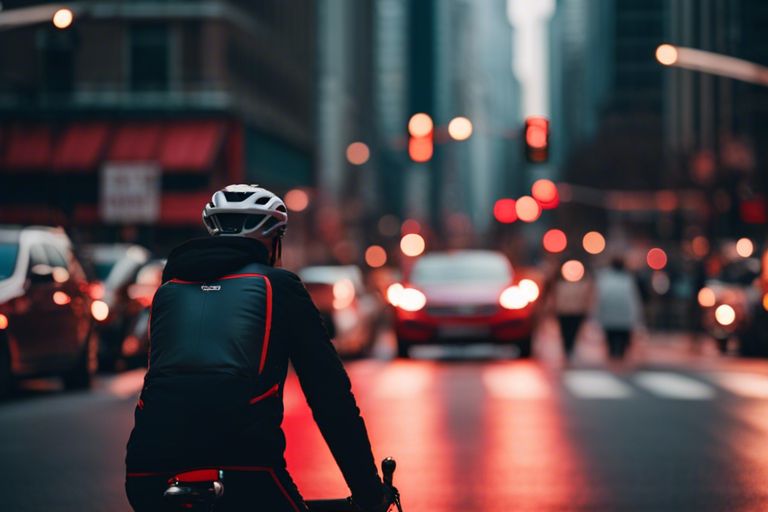Lights at intersections serve as a means to regulate traffic flow and ensure the safety of all road users. In terms of bicycles, there is often confusion surrounding whether they are required to stop at red lights like other vehicles. In this blog post, we will discuss the rules and regulations regarding cyclists and red lights to provide clarity on this important issue.
Key Takeaways:
- Bicycles are considered vehicles: Bicycles are subject to the same traffic laws as other vehicles, including respecting red lights.
- Some regions may have different laws: It is important to be aware of local laws and regulations regarding cyclists and red lights, as they can vary from place to place.
- Safety always comes first: Even when permitted to proceed through a red light under certain conditions, cyclists should always prioritize their safety and that of others on the road.
Understanding Traffic Laws for Cyclists
The Basics of Road Rules for Bicycles
While cyclists often share the road with motor vehicles, they are subject to similar traffic laws. This means that cyclists must obey stop signs, traffic signals, and yield to pedestrians at crosswalks. Understanding and following these basic road rules can help create a safer environment for all road users.
Variations in Traffic Laws by Jurisdiction
Basics of traffic laws for cyclists remain consistent across most jurisdictions, but it’s important to be aware of any variations that may exist in different regions. Some cities may have specific rules for cyclists, such as requiring them to use designated bike lanes or prohibiting cycling on certain roadways. Being informed about these variations can help cyclists avoid potential fines or conflicts with law enforcement.

The Significance of Red Lights in Traffic Regulation
Purpose of Red Lights for All Road Users
It is crucial to understand the importance of red lights in traffic regulation. Red lights serve as a universal signal for all road users to come to a stop. They signify the need for vehicles and pedestrians to yield the right of way and allow safe passage to cross traffic. This standardized system helps maintain order and safety on the roads, preventing accidents and ensuring smooth traffic flow.
Specific Implications for Bicyclists
Lights. The significance of red lights, especially for bicyclists, cannot be overstated. While cyclists are more agile than motor vehicles, they are still bound by the same traffic rules and regulations. When approaching a red light, cyclists are required to come to a complete stop, just like any other vehicle on the road. This not only promotes consistency and respect for traffic laws but also enhances overall safety for cyclists and other road users.
Plus, disregarding red lights can lead to serious consequences, including accidents, injuries, and legal implications. Therefore, it is vital for bicyclists to adhere to traffic signals, including red lights, to ensure their safety and the safety of others on the road.

Safety Considerations for Bicyclists at Intersections
Potential Hazards of Red Light Ignorance
On the road, safety should always be a top priority for all users, including bicyclists. Ignoring red lights at intersections is not only illegal but also extremely dangerous. By running red lights, cyclists put themselves at risk of getting hit by vehicles, causing serious accidents and injuries not only to themselves but also to others on the road. As a responsible cyclist, it is crucial to obey traffic signals and respect the rules of the road to ensure a safe journey for everyone.
Best Practices for Cyclists at Traffic Signals
Bicyclists have a responsibility to follow the same traffic laws as motor vehicles, including stopping at red lights. When approaching a red light at an intersection, cyclists should come to a complete stop, look both ways for oncoming traffic, and wait for the signal to turn green before proceeding. It is important to position yourself in the designated area for cyclists at intersections and always be attentive to other vehicles and pedestrians sharing the road.
To further enhance safety at traffic signals, cyclists can also consider making eye contact with drivers to ensure they have been seen before crossing the intersection, using hand signals to indicate their intentions, and wearing brightly colored or reflective clothing to increase visibility. By practicing these best practices, cyclists can reduce the risk of accidents and contribute to a safer road environment for everyone.

Legal Consequences of Failing to Stop
Your question on whether cyclists have to stop at red lights is one that many people have. It is important to understand the legal consequences for failing to stop at a red light while riding a bike.
Penalties for Bicyclists Running Red Lights
Bicyclists who run red lights can face various penalties, depending on the state or country’s laws. In many jurisdictions, running a red light on a bicycle is considered a traffic violation and can result in fines. Repeat offenders may face more severe consequences, such as license suspension or mandatory safety courses.
The Role of Law Enforcement in Promoting Compliance
The role of law enforcement in promoting compliance with traffic laws, including stopping at red lights, is crucial for ensuring the safety of all road users. Police officers may conduct enforcement operations targeting cyclists who violate traffic signals to educate them about the importance of following the rules and to deter future infractions.
Legal repercussions for failing to stop at red lights while riding a bike are put in place to protect the safety of cyclists and other road users. It is important for all cyclists to adhere to traffic laws and signals to prevent accidents and promote harmony on the roads.
Conclusion
Following this, it is clear that bicycles are required to follow the same traffic laws as motor vehicles when it comes to stopping at red lights. This is crucial for the safety of both cyclists and drivers on the road. By following the rules and regulations, cyclists can contribute to a safer and more organized traffic flow. It is recommended that cyclists always come to a complete stop at red lights and obey traffic signals to ensure the safety of themselves and others. Note, it is important to always prioritize safety while biking on the road.
FAQ
Q: Do bikes have to stop at red lights?
A: Yes, bicycles are required to obey traffic signals, including red lights. Just like motor vehicles, cyclists must come to a complete stop at red lights and only proceed when it is safe to do so. Failing to stop at a red light can result in a citation or penalty.
Q: Can cyclists proceed through a red light if there is no traffic?
A: No, cyclists must wait for the traffic light to turn green before proceeding, even if there is no other vehicles around. Running a red light, regardless of the traffic conditions, is illegal and unsafe. It is important for cyclists to follow all traffic signals to ensure their safety and the safety of others.
Q: Are there any exceptions for cyclists at red lights?
A: In some jurisdictions, there are laws that allow cyclists to proceed through a red light after coming to a complete stop if the light fails to detect their presence. This is often referred to as the “Idaho stop” law. However, it is important for cyclists to familiarize themselves with the specific traffic laws in their area to determine if such exceptions apply.




